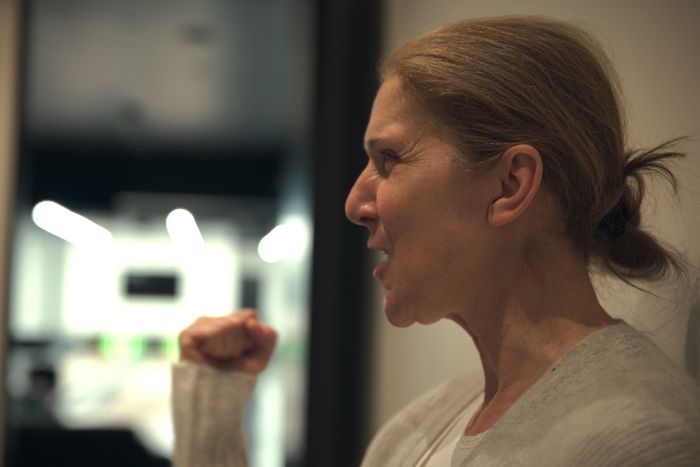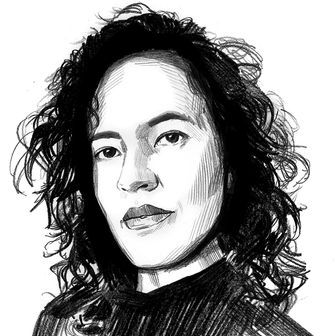
Yes, she was feeling it during her first Vegas residency, the one that began in 2003. And the follow-up. And during the 2008 world tour and the next tour and all the other tours after that. As Céline Dion remembers it in I Am: Celine Dion — a documentary that obscures her intellectual life while unveiling her physical one — her voice was the first part of her to register the symptoms of a rare neurological disorder called stiff-person syndrome. Normally, after a show, her vocals would drop at least a half-note. One day, she noticed her voice went up instead. Then it began to burn out. Sometimes she’d buy time onstage by turning the mic toward the crowd and asking them to sing, an act of desperation disguised as generosity. She kept doing shows, kept belting, kept swiveling her hips and waggling one leg like a lanky French Canadian Elvis. She vamped her way through the pain for 17 years, as her voice failed and her muscles rebelled and spasms turned to seizures. “By 2020,” she tells the camera, “I could barely walk.”
I first watched the film, which debuted on Amazon Prime Video this week, at its Lincoln Center premiere. The venue was full of press and fans who sang along to the hits piped in before the screening. Some wore suits and gowns; others wore tour T-shirts; one guy, extra yoked, wore a racerback tank with a picture of Céline in full sequins covering the front. It was the most hyped crowd possible for a heroic return, and when the 56-year-old star herself walked onstage in cream silk to introduce the film, everyone got up and yelled. She looked, to be honest, great — and her presence offered reassurance: If she was here in person, how bad could she really be doing?
I Am: Celine Dion lets you decide. Without ever really questioning the accepted model of the star-approved, publicist-molded documentary — which, directed by Irene Taylor, was co-produced by Céline’s company, Les Productions Feeling — the film lands somewhere between hand-holding fan service and brutal portrait of chronic illness. Céline is one of the few living singers whose work is so ubiquitous, it textures the world’s nostalgia. But this film suggests a new status for her: that of an injured athlete.
It’s not just the way she talks. Like a lot of athletes, Céline Dion has little to tell her public about why or how she does what she does. (And you won’t hear it from anyone else, either; she and her twin sons are the only people who speak directly to camera.) Of her backing band, she says, “All we wanted was to be the best of each and every one of us.” Of teamwork in general, she says, “If you wanna go fast, go alone. And if you wanna go far, go together.” Of herself, she offers: “The person that I am today, I didn’t create myself. I didn’t invent myself. I am.” Even now, she’s prone to breaking into song halfway through a sentence. She doesn’t say what she likes about the music she’s recorded — she has admitted in the past that she once hated “My Heart Will Go On” — but she will say that song choice doesn’t matter much to her. In her view, “The performance is way bigger than the song.”
Taylor, the film’s director, doubles down on that view. I Am: Celine Dion is packed with concert footage, inviting us to appreciate her greatness through her enormous physicality. Although we do see clips from past studio sessions, in which Céline stands still while the ballads barrel out of her like a freight train, we spend more time watching her onstage, tossing back her blowout as she shoots to crescendo. The stomp and twirl of those long gazelle legs, that flung-out wingspan that seemed as wide as the stadium. (I’d always thought of Céline as one of the iconic tall girls. I was shocked to learn we’re allegedly the same height: five-foot-seven.) Taylor wants us to know that before Céline got sick, the woman was never not in command of her entire body. From the ’80s to the 2000s, there she is, sprinting, leaping, high stepping, pointing, gyrating. We see her stretching and rehearsing in dancer gear before a show, working it out alone or with her backup performers. We see her bounce across a stage in black pleather so she can stand in front of her guitarist, thrust her hips, tickle her air guitar, and ape the sound of his instrument with her voice. Sometimes that voice is played as the teasing prelude to the full, 360 song-and-dance experience. In one concert clip, she begins her hit “The Power of Love” shrouded in darkness, vocals booming from a Céline-shaped hole: “I hold on to your body / And feel each move you make …” When she arrives at “’Cause I’m your lady …” the lights come up to reveal her in gold sequins, pointing right at you: “And you are my man.”
The power of the concert scenes is juxtaposed almost immediately with a more recent cell-phone video of Céline lying prone on the ground, paralyzed by seizure. She moans in pain as EMTs lift her onto a gurney. The raw clip exemplifies the film’s revelations, which are all about Céline’s physical state. (If you’re hoping to learn more about her relationship with her late husband, René Angélil, who discovered her when she was 12 and whom she married when she was 26, you will be disappointed; all she will say is that he was “the love of my life.”) When the film opens, Céline says she hasn’t sang in two years because the illness restricts the muscles in her chest. We get to watch her try, and it’s painful. As she works to record a new song, she strains to touch notes that you’d expect her to fly through. After one attempt, she is so overstimulated that she goes into crisis, during a sports-medicine therapy session. Her feet spasm, then her hands. She goes from lucid to full-blown seizure, her face a mask of fear and pain — and the camera keeps rolling. Her team is there, tending to her and administering medication, but she still has to struggle through it to the end, when she sits up, wrapped in a blanket, humiliated. It’s one of the most vulnerable moments I’ve ever seen in a film about a celebrity, especially one co-produced by the celebrity herself.
However, since Céline approved everything in this project, even an abject moment serves a purpose. One could imagine that the singer is so optimistic about her recovery that she wants viewers to see her at a low point, all the better to appreciate her triumph later — perhaps her most athlete-like impulse. (She did just tell the BBC she’s planning a new Vegas show.) Or we could decide that she just wants to be transparent, although this is the same woman who refuses to answer when one of her sons asks “What’s your favorite color?” in front of the cameras. I think it’s two things: one, that she hopes it will make fans struggling with illness and disability feel less alone — philanthropy for conditions from cystic fibrosis to AIDS has been part of her brand for decades. Two, that she may feel showing herself in crisis is the best possible answer to fans still wondering why she’s not touring and putting out music. She seems to feel guilty about this, at one point comparing herself to an apple tree that used to produce perfect fruit but whose branches are starting to die.
My first time viewing the film, I almost didn’t notice how little Céline does in it. Nearly all of the new footage shows her padding around her Vegas manse or goofing around with her kids or doing sports-medicine sessions. Her biggest excursions are to the warehouse where she keeps her personal archive and costumes, and to a recording studio where she can dub her own lines in the French version of the Priyanka Chopra rom-com Love Again. On rewatch I could see how hard Taylor had to work that archival footage — all those displays of power and finesse — to lessen the film’s claustrophobia. Céline is a woman who was once so self-possessed that she could pull off performing a ragga song at the Essence Awards in her own version of patois. Now, we watch her listen to playback of her struggling singing voice and see her face turn to stone. She shakes her head, disturbed by this double fault that should’ve been an ace. “Je n’aime pas ça,” she tells her recording engineers and looks about to cry.
Some athletes retire when they start to slow down. They know what’s coming and want to end on their terms. Others keep pushing till their bodies refuse them. The film tells us that Céline is the second kind. We hear again and again that she isn’t done performing, that she will find a way to fill stadiums again. The film strains to imply a future that its depiction of the present doesn’t promise — because for Céline, to be onstage is to exist. To be is to belt. “I think I was very good,” she says at one point. “I think I had some stuff that was amazing. But there’ve been moments when I had to go to the studio and I knew they wanted ‘Céline Dion’” — and she could not give it to them. What would it mean to be Céline Dion anyway? Céline sighs as she summarizes: “She’s the best.”





